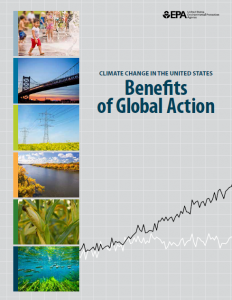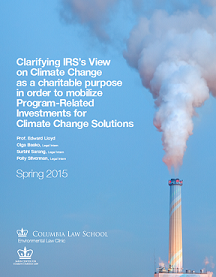 Grant Glovin
Grant Glovin
Sabin Center Summer Intern
Last week, the Environmental Protection Agency (EPA) released a report, “Climate Change in the U.S. – Benefits of Global Action,” detailing the findings of the EPA’s Climate Change Impacts and Risk Analysis (CIRA) study, a peer reviewed project that seeks to assess climate change risk at a regional and sectorial level. Unsurprisingly, the report finds that, in almost all of the 20 sectors discussed, mitigation results in substantial economic benefits, with savings in individual sectors often reaching billions of dollars. Examples include labor (where mitigation would save $110 billion by decreasing the number of extremely hot days where work is impossible), water quality (at least $2.6 billion saved), agriculture ($6.6 to $11 billion saved), road maintenance ($4.2 to $7.4 billion saved), droughts ($9.3 to $34 billion saved due to effects on agriculture), and water supply ($11 to $180 billion). The report also notes that the costs of mitigation, which would primarily affect the energy supply sector, would be comparable to the costs for energy alone in a business-as-usual scenario, before accounting for adaptation or economic harm.
The report analyzes impacts under two scenarios. In the first, a business-as-usual scenario, emissions continue to increase at a steady rate, resulting in an atmospheric carbon dioxide concentration of 826 ppm in 2100. In the second scenario, considerable mitigation efforts lead to a peak in U.S. emissions before 2025, followed by a decline to twenty-eight percent of 2005 emissions levels in 2100. This is less ambitious than President Obama’s goals, which call for cutting greenhouse gasses to that level in 2025, but more in line with scenarios modeled by the Intergovernmental Panel on Climate Change (which this report compares to its two scenarios). The report uses two climate models, and links them to more specific, sector-based analyses in order to evaluate sectorial risk and quantify the costs associated with adaptation, productivity loss, and any other economic harm.
The report is notable for its focus on the economic costs of climate change impacts and adaptation responses, as opposed to a more eco-centric analysis of environmental and social harms that could be attributed to climate change. Rather than seeking to express damage to, for example, coral reefs in terms of the environmental harm associated with the destruction of the ecosystem, the report monetizes the losses associated with destruction of coral reefs. This focus is reminiscent of an approach taken in 2006 by the United Kingdom government in the Stern Review on the Economics of Climate Change, which both analyzed the impacts of climate change on the global economy and made quantified recommendations regarding investment into climate change adaptation and mitigation. Similar work was also undertaken in a 2011 World Bank study that estimated global adaptation costs in 2050 will amount to between $70 billion and $100 billion per year. The CIRA report also complements the 2014 National Climate Assessment (NCA), adding an economic dimension to the NCA’s more scientific focus. Whereas the National Climate Assessment contains a more detailed description of potential climate change impacts and adaptation opportunities, the CIRA study better illustrates the comparative costs of mitigation and adaptation.
In detailing these costs, EPA states it has considered adaptation where the data is available and, in certain instances, where the cost of adaptation is an appropriate metric to assess climate change damages. (Section D of the Technical Appendix to the report notes how adaptation was treated in each sector). As a result, the report does not have a standard methodology for integrating adaptation into its estimates of economic costs and public health impacts. The analysis of extreme temperature and impacts on public health, for example, finds that extremely hot days could lead to an increase of 2,600 deaths in 2050 and 13,000 deaths from heat in 2100, and notes that “accounting for adaptation could decrease these numbers” without discussing what adaptation measures might be undertaken in this context, how much they might cost, and how many lives could be saved. In contrast, the report does estimate the costs of adaptation for three of the four infrastructure sectors analyzed (bridges, roads, and urban drainage), but it does not estimate the potential economic damage that may occur in the absence of those adaptation measures. There is one exception—the report notes that adaptation measures to protect coastal property will reduce the total cost of damages from $5 trillion to $810 billion.
Some of the report’s assumptions about adaptation may be overly optimistic. The NCA noted that adaptation was, aside from some incremental measures, largely still in the planning stage, and has not received adequate funding or political support. The situation in some regions seems particularly dire: the EPA report highlights Tampa, Florida, as an example of a coastal region that could be severely impacted by climate change, with 83,000 acres of land projected to be at risk of inundation in 2100. Despite the extreme need for adaptation to sea level rise, Florida governor Rick Scott has shown no willingness to take on these challenges, going so far as to expunge use of the term “climate change” from official in Florida’s Department of Environmental Protection. The CIRA report might thus be overly optimistic in forecasting the degree to which climate change adaptation will occur in the U.S.
The report gives multiple compelling reasons why the development and implementation of a strong climate change mitigation plan is crucial. Even assuming that adaptation does occur to the extent predicted in the report, the total costs will be substantial. These economic forecasts could be significantly worse if national adaptation efforts are lackluster.



